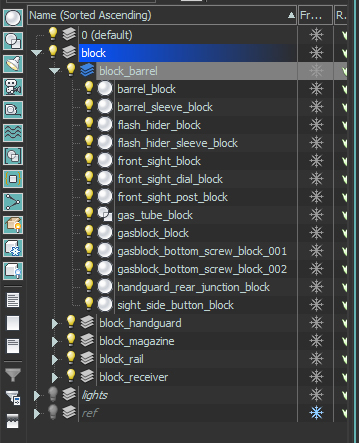The BRAWL² Tournament Challenge has been announced!
It starts May 12, and ends Oct 17. Let's see what you got!
https://polycount.com/discussion/237047/the-brawl²-tournament
It starts May 12, and ends Oct 17. Let's see what you got!
https://polycount.com/discussion/237047/the-brawl²-tournament
MK12 SPR
As a side project I'm making a game-ready Mark 12 Special Purpose Rifle, which is a designated marksman variant of the M16 featuring a floated handguard and shorter barrel. I picked this gun because it has a nice balanced distribution of weight and I really like the large forms spattered with tertiary details. For a change I'm going to document the process I go through in more detail than the usual trickle of images to a sketchbook thread.

Step zero was setting up the project directory and doing research. I've been using this same basic project setup for many years now. Having consistent organizational practices is very helpful. With familiarity your brain will stop having to think about where files are located or what to call them and you spend less time distracted from moving forward. If you're a Max user... Customize > Configure User Paths

Reference images... get more than you need in the highest quality possible. For any given gun I will spend at least an hour (usually 2-3) dredging up pictures on auction sites and forums. This particular gun has an extensive thread on ar15 dot com which I mined for pictures showing various models and angles as well as material finishes.
You gotta watch out for airsoft guns when you dig around, be careful for that. The main things to look out for are the magazine, chamber, bolt, and barrel because all these are different for BBs than cartridges. Airsoft guns are sometimes the only references you can find for certain angles or views but just use a real reference if you possibly can.
Sometimes you might find it useful to make collages of references instead of just saving a ton of them as I did here. I will usually use collages on environments or vehicles where there are many distinct areas each of which needs its own set of references. On guns, which are smaller in scope, I tend to just throw them into a folder and then mark particularly useful ones with an alphanumeric character that sorts them to the front.

Enough of the boring s***, let's talk about modeling right?

All of this I still consider as the blockout stage. In this shot you can see a few different techniques being used. The bipod legs are barely-modified primitives, the bipod mount plate is plane-modeled with a shell modifier, and the gas block, front sight, handguard, and rails are all proboolean objects. If you aren't familiar with boolean techniques for hardsurface modeling I really recommend this previous thread.
So point here being, any modeling technique is fine, every model I make ends up using various techniques on various parts. There is no one technique to treat everything with. For every given shape there's going to be a whole spectrum of ways to accomplish it that vary in their efficiency and dependencies. I think a great rule of thumb is to keep it simple. The more complicated a part is, the more you might want to think about how to do it properly. But you don't have to hold yourself to one particular way of modeling.
Another boring organizational note, I name everything. You should name everything too if you ask me. The downside is very small, it takes almost no time. If you're making something in your scene, you probably had a thought that led to you making it. Take that thought, and write it down in the name of the object. That's all you have to do to keep everything named in your scene. We're artists, I get it. Free spirits. But this kind of discipline will help a lot down the line, when you're opening up a file from 8 months ago trying to identify what Box126 is doing. Or how about when a coworker or client has to edit this file three years from now when it's being re-used in a totally different game? Have some consideration, please.

Here's a shot showing a typical working scenario. I only have one monitor at home right now so I work in split screen like this. Note that every feature is pretty much its own operand in the proboolean stack, so they can all be dialed up and down in resolution independently of each other. Also note that they're named, so it's no guesswork to instantly get to a desired feature.

Sometimes people have asked me about this particular aspect of the proboolean workflow, and what I mean by using modifiers on operands to control resolution. Hopefully this image illustrates what I mean. When every geometric feature is represented by an operand, you can achieve granular control of each feature's smoothness by using subd and other modifiers on the operand itself, meaning you can change features in isolation. Very useful for the lowpoly later on!

